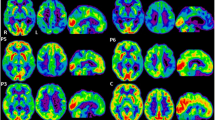Abstract
The rebuilding of the N family, a large Italian kindred affected by early-onset autosomal dominant Alzheimer’s disease (AD), provided an important contribution to the discovery of Presenilin 1 (PSEN1), the main gene responsible for familial AD. This pedigree was identified with the help of medical records from the archives of the Psychiatric Hospital of Girifalco, Italy. The clinical record of Angela R., an ancestor of the N family, dating back to 1904, showed a clinical picture of Angela R., consistent with a diagnosis of non-amnestic probable AD, matching the “dysexecutive” phenotype described in her descendants. The a posteriori diagnosis of AD is supported by the evidence of the causative genetic mutation PSEN1-Met146Leu as well as neuropathological AD features in her genealogically proven descendants. The clinical case of Angela R. was recorded at the same time of Alzheimer’s description of Auguste D. Its discovery crucially contributed to the genealogical reconstruction of the N family, linking came from different branches, which until then were unrelated, to the same kindred. The archives of the Girifalco Hospital represented a valuable source of medical and historical information and were essential to the research on Italian-American AD families that finally led to the identification of new genes.


Similar content being viewed by others
References
Alzheimer A, Stelzmann RA, Schnitzlein HN, Murtagh FR (1995) An English translation of Alzheimer’s 1907 paper, “Uber eine eigenartige Erkankung der Hirnrinde”. Clin Anat 8:429–431
Bonfiglio F (1908) Di speciali reperti in un caso di probabile sifilide cerebrale. Riv Sper Freniatr 34:196–206
Perusini G (1910) Über klinisch und histologisch eigenartige psychische Erkrankungen der späteren Lebensalters. Histologische und histopathologische Arbeiten über die Grosshirnrinde 3:297–351
Sherrington R, Rogaev EI, Liang Y et al (1995) Cloning of a gene bearing missense mutations in early-onset familial Alzheimer’s disease. Nature 375:754–760
Bruni AC, Bernardi L, Colao R et al (2010) Worldwide distribution of PSEN1 Met146Leu mutation: a large variability for a founder mutation. Neurology 74:798–806
Foncin JF, Salmon D, Supino-Viterbo V et al (1985) Demence presenile d’Alzheimer transmise dans une famille etendue. Rev Neurol (Paris) 141:194–202
Foncin JF, Salomon D, Bruni AC (1989) Notes on the methods for the study of kindreds with familial Alzheimer’s disease. In: Miner GD, Richter RW, Blass JP, Valentine JL, Winters-Miner LA (eds) Familial Alzheimer’s disease. Molecular genetics and clinical perspectives. Marcel Dekker, Inc. New York and Basel, pp 45–53
Feldman RG, Chandler KA, Levy LL, Glaser GH (1963) Familial Alzheimer’s disease. Neurology 13:811–824
McKhann GM, Knopman DS, Chertkow H et al (2011) The diagnosis of dementia due to Alzheimer’s disease: recommendations from the National Institute on Aging-Alzheimer’s Association workgroups on diagnostic guidelines for Alzheimer’s disease. Alzheimers Dement 7:263–269
Maurer K, Volk S, Gerbaldo H (1997) Auguste D and Alzheimer’s disease. Lancet 349:1546–1549
Pollen DA (1993) The life and death of Hannah. In: Hannah’s Heirs: the quest for the genetic origins of Alzheimer’s disease. Oxford University Press, pp 12–14
Pollen DA (1993) Peter St. George-Hyslop and the link to chromosome 21. In: Hannah’s Heirs: the quest for the genetic origins of Alzheimer’s disease. Oxford University Press, p 145
Yu G, Nishimura M, Arawaka S, Levitan D et al (2000) Nicastrin modulates presenilin-mediated notch/glp-1 signal transduction and betaAPP processing. Nature 407:48–54
Acknowledgments
This work has been supported by the project “Invecchiamento—ALPHA (eAsy inteLligent service Platform for Healthy Ageing)” of the Italian National Research Council (CRN).
Author information
Authors and Affiliations
Corresponding author
Ethics declarations
Conflicts of interest
The authors declare that they have no conflict of interest.
Ethical standard
The study was approved by the local Ethics Committee (prot. n 125, 14/05/2015; Regione Calabria Area Centro), and performed according to the ethical standards laid down in the 1964 Helsinki Declaration and its later amendments.
Additional information
L. Borrello, C. Cupidi and V. Laganà equally contributed to this work.
Rights and permissions
About this article
Cite this article
Borrello, L., Cupidi, C., Laganà, V. et al. Angela R.: a familial Alzheimer’s disease case in the days of Auguste D.. J Neurol 263, 2494–2498 (2016). https://doi.org/10.1007/s00415-016-8294-x
Received:
Revised:
Accepted:
Published:
Issue Date:
DOI: https://doi.org/10.1007/s00415-016-8294-x




